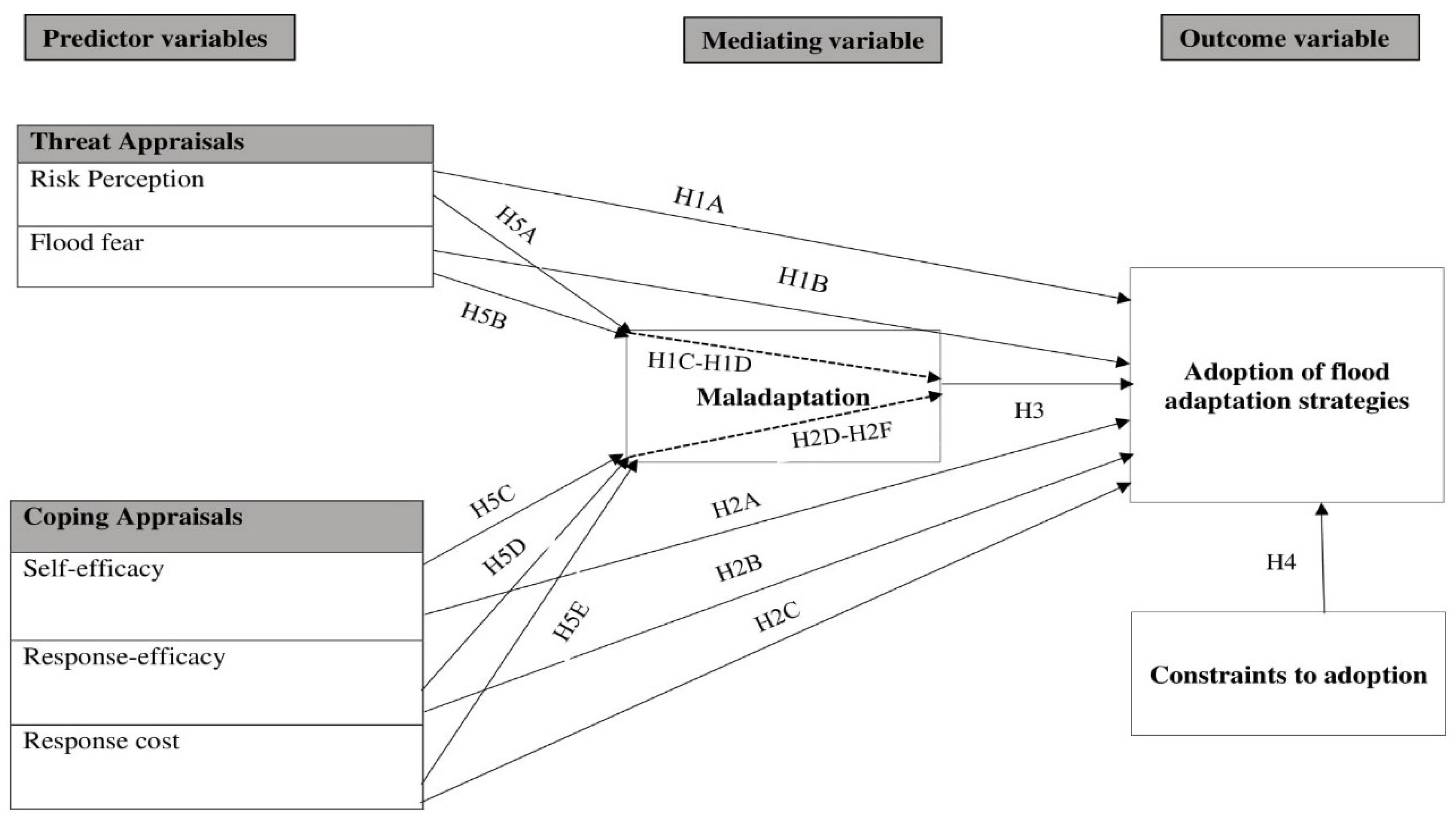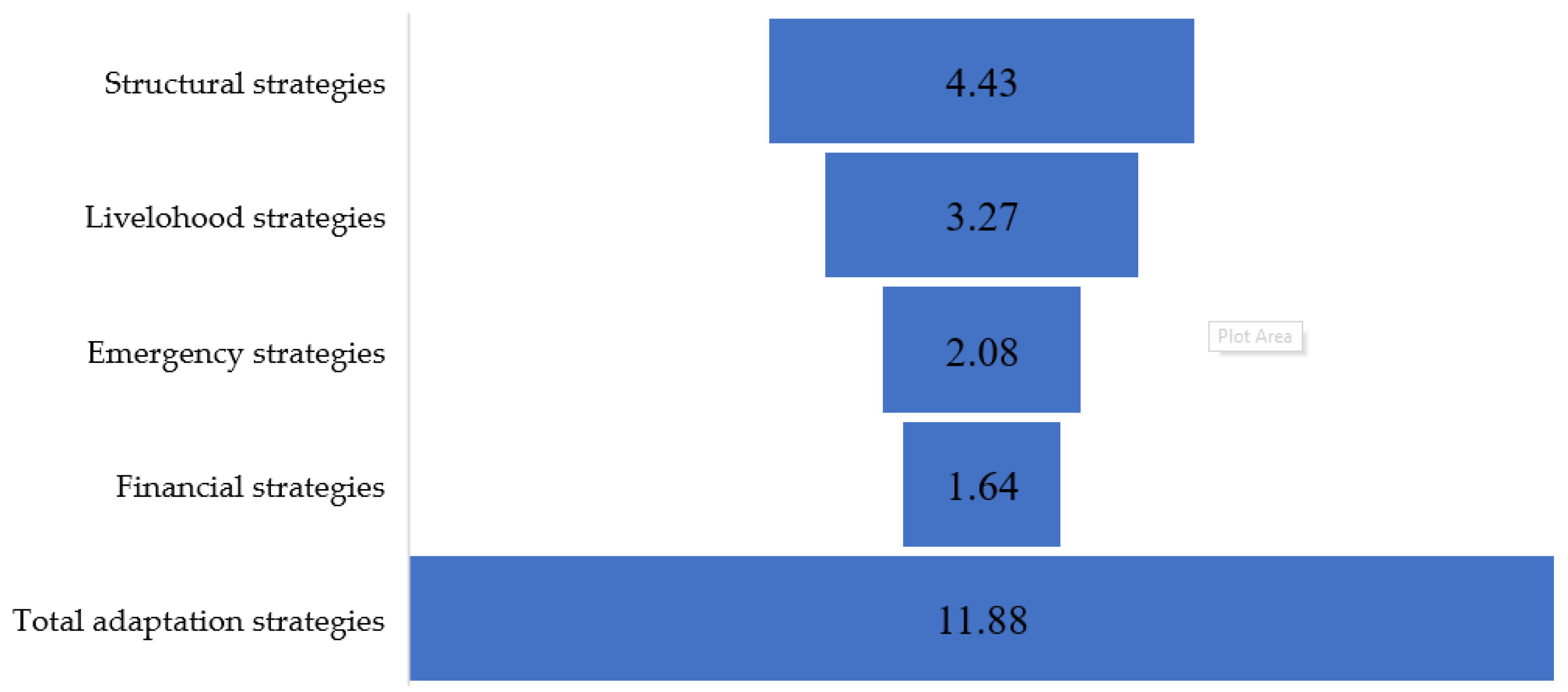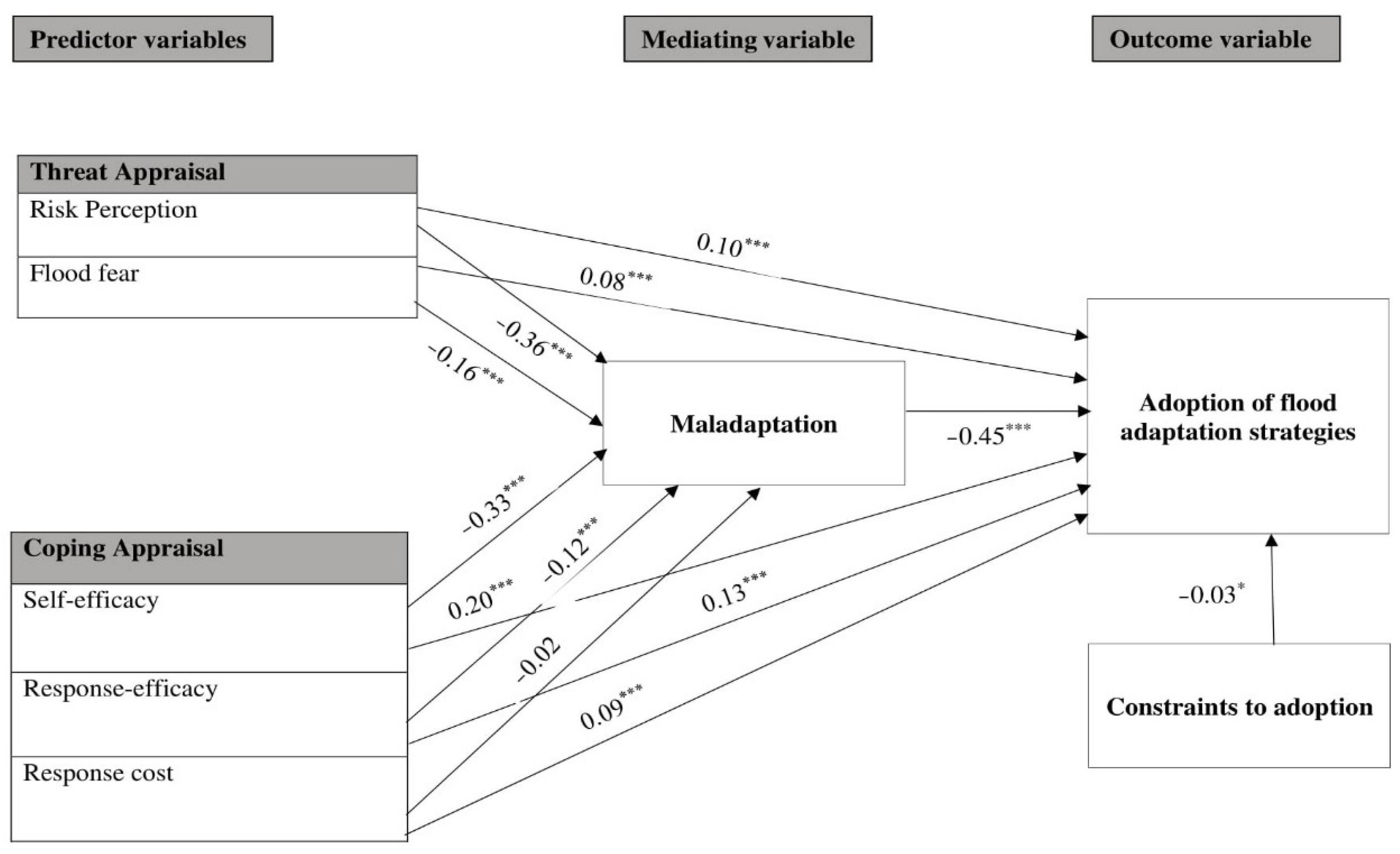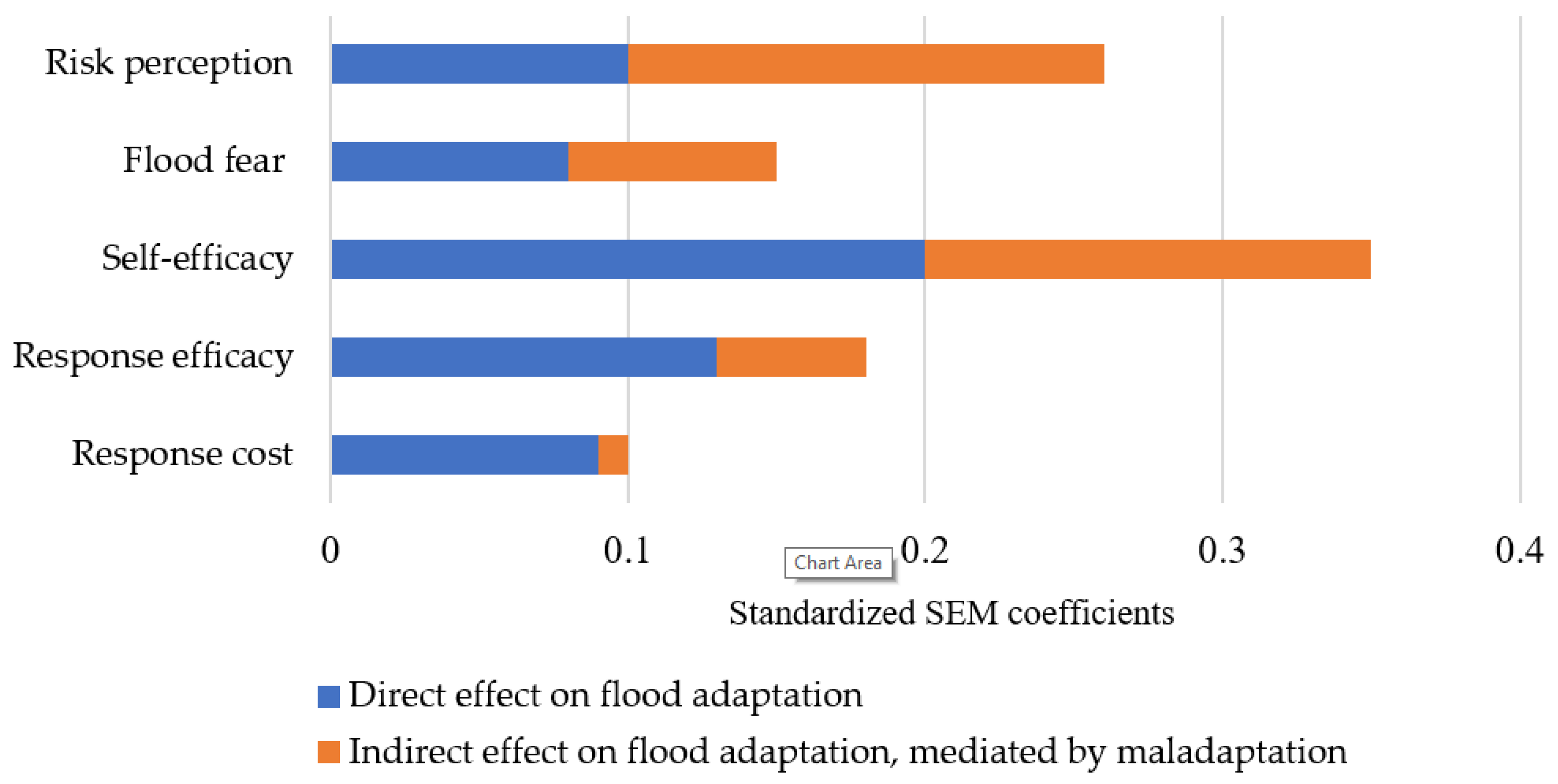Factors Affecting Farmers’ Adoption of Flood Adaptation Strategies Using Structural Equation Modeling
Abstract
1. Introduction
2. Theory and Hypothesis
3. Materials and Methods
3.1. Study Locale, Sampling and Data Collection
3.2. Measurement of Variables
3.3. Analytical Method
4. Results
4.1. Descriptive Results
4.1.1. Sociodemographic Characteristics
4.1.2. Farmers’ Adoption of Flood Adaptation Strategies
4.2. Path Analysis Results
4.2.1. Model Fitting Results
4.2.2. Analysis of the Model Effects
- (1)
- Direct effects
- (2)
- Indirect or mediation effects
- (3)
- Total effects
4.2.3. Robustness Check with Sobel Test and Baron Kenny Approach
5. Discussion
6. Conclusions and Policy Recommendations
Author Contributions
Funding
Institutional Review Board Statement
Informed Consent Statement
Data Availability Statement
Acknowledgments
Conflicts of Interest
References
- Islam, M.A.; Solaiman; Islam, M.S.; Tusher, T.R.; Kabir, M.H. Impacts of flood on Char livelihoods and its adaptation techniques by the local people. Bangladesh J. Sci. Res. 2015, 28, 123–135. [Google Scholar] [CrossRef]
- Relief MODMA. Disaster Report Dhaka: Department of Disaster Management 2013. Available online: https://reliefweb.int/report/bangladesh/disaster-report-2013 (accessed on 18 June 2022).
- Hossain, B. Role of organizations in preparedness and emergency response to flood disaster in Bangladesh. Geoenviron. Disasters 2020, 7, 33. [Google Scholar] [CrossRef]
- Philip, S.; Sparrow, S.; Kew, S.F.; van der Wiel, K.; Wanders, N.; Singh, R.; Hassan, A.; Mohammed, K.; Javid, H.; Haustein, K.; et al. Attributing the 2017 Bangladesh floods from meteorological and hydrological perspectives. Hydrol. Earth Syst. Sci. 2019, 23, 1409–1429. [Google Scholar] [CrossRef]
- International Federation of Red Cross and Red Crescent Societies (IFRC). Bangladesh: Monsoon Floods. 2021. Available online: https://reliefweb.int/report/bangladesh/bangladesh-monsoon-floods-final-report-n-mdrbd025 (accessed on 10 July 2022).
- Kelly, C.; Chowdhury, M.H.K. Poverty, Disasters and the Environment in Bangladesh: A Quantitative and Qualitative Assessment of Causal Linkages; Bangladesh Issues Paper; UK Department for International Development: Dhaka, Bangladesh, 2002. [Google Scholar]
- Mondal, M.S.; Rahman, M.A.; Mukherjee, N.; Huq, H.; Rahman, R. Hydro-climatic hazards for crops and cropping system in the chars of the Jamuna River and potential adaptation options. Nat. Hazards 2015, 76, 1431–1455. [Google Scholar] [CrossRef]
- Paul, S.; Islam, M.R. Ultra-poor char people’s rights to development and accessibility to public services: A case of Bangladesh. Habitat Int. 2015, 48, 113–121. [Google Scholar] [CrossRef]
- Banglapedia. Char. Available online: https://en.banglapedia.org/index.php/char (accessed on 15 July 2022).
- Irrigation Support Project for Asia and Near East (ISPAN). Char-Land Study Overview: Summary Report (Draft); Flood Plain Coordination Organization, Ministry of Irrigation, Water Development and Flood Control: Dhaka, Bangladesh, 2003. [Google Scholar]
- Hossain, B.; Sohel, M.S.; Ryakitimbo, C.M. Climate change induced extreme flood disaster in Bangladesh: Implications on people’s livelihoods in the Char Village and their coping mechanisms. Prog. Disaster Sci. 2020, 6, 100079. [Google Scholar] [CrossRef]
- Bubeck, P.; Botzen, W.J.W.; Kreibich, H.; Aerts, J.C.J.H. Detailed insights into the influence of flood-coping appraisals on mitigation behaviour. Glob. Environ. Chang. 2013, 23, 1327–1338. [Google Scholar] [CrossRef]
- Grothmann, T.; Reusswig, F. People at risk of flooding: Why some residents take precautionary action while others do not. Nat. Hazards 2006, 38, 101–120. [Google Scholar] [CrossRef]
- Bostrom, A.; Morss, R.E.; Lazo, J.K.; Demuth, J.L.; Lazrus, H.; Hudson, R. A mental models study of hurricane forecast and warning production, communication, and decision-making. Weather. Clim. Soc. 2016, 8, 111–129. [Google Scholar] [CrossRef]
- Box, P.; Thomalla, F.; Van den Honert, R. Flood Risk in Australia: Whose Responsibility Is It, Anyway? Water 2013, 5, 1580–1597. [Google Scholar] [CrossRef]
- Morss, R.E.; Demuth, J.L.; Bostrom, A.; Lazo, J.K.; Lazrus, H. Flash Flood Risks and Warning Decisions: A Mental Models Study of Forecasters, Public Officials, and Media Broadcasters in Boulder, Colorado. Risk Anal. 2015, 35, 2009–2028. [Google Scholar] [CrossRef]
- Scolobig, A.; Prior, T.; Schrter, D.; Jrin, J.; Patt, A. Towards people-centred approaches for effective disaster risk management: Balancing rhetoric with reality. Int. J. Disaster Risk Reduct. 2015, 12, 202–212. [Google Scholar] [CrossRef]
- Bubeck, P.; Botzen, W.J.W.; Aerts, J.C.J.H. A Review of Risk Perceptions and Other Factors that Influence Flood Mitigation Behavior. Risk Anal. 2012, 32, 1481–1495. [Google Scholar] [CrossRef] [PubMed]
- Poussin, J.K.; Botzen, W.J.W.; Aerts, J.C.J.H. Factors of influence on flood damage mitigation behaviour by households. Environ. Sci. Policy 2014, 40, 69–77. [Google Scholar] [CrossRef]
- Aerts, J.C.J.H.; Botzen, W.J. Flood-resilient waterfront development in New York City: Bridging flood insurance, building codes, and flood zoning. Ann. N. Y. Acad. Sci. 2011, 1227, 1–82. [Google Scholar] [CrossRef]
- Lo, A. The role of social norms in climate adaptation: Mediating risk perception and flood insurance purchase. Glob. Environ. Chang. 2013, 23, 1249–1257. [Google Scholar] [CrossRef]
- Kreibich, H.; Christenberger, S.; Schwarze, R. Economic motivation of households to undertake private precautionary measures against floods. Nat. Hazards Earth Syst. Sci. 2011, 11, 309–321. [Google Scholar] [CrossRef]
- Meyer, R.J.; Baker, J.; Broad, K.; Czajkowski, J.; Orlove, B. The Dynamics of Hurricane Risk Perception: Real-Time Evidence from the 2012 Atlantic Hurricane Season. Bull. Am. Meteorol. Soc. 2014, 95, 1389–1404. [Google Scholar] [CrossRef]
- Schmuck, H. “An Act of Allah”: Religious Explanations for Floods in Bangladesh as Survival Strategy. Int. J. Mass Emergencies Disasters 2000, 18, 85–96. [Google Scholar]
- Owusu, S.; Wright, G.; Arthur, S. Public attitudes towards flooding and property-level flood protection measures. Nat. Hazards 2015, 77, 1963–1978. [Google Scholar] [CrossRef]
- Liu, D.; Li, Y.; Shen, X.; Xie, Y.; Zhang, Y. Flood risk perception of rural households in western mountainous regions of Henan Province, China. Int. J. Disaster Risk Reduct. 2018, 27, 155–160. [Google Scholar] [CrossRef]
- Kellens, W.; Terpstra, T.; De Maeyer, P. Perception and Communication of Flood Risks: A Systematic Review of Empirical Research. Risk Anal. 2013, 33, 24–49. [Google Scholar] [CrossRef] [PubMed]
- Floyd, D.L.; Prentice-Dunn, S.; Rogers, R.W. A Meta-Analysis of Research on Protection Motivation Theory. J. Appl. Soc. Psychol. 2000, 30, 407–429. [Google Scholar] [CrossRef]
- Milne, S.; Sheeran, P.; Orbell, S. Prediction and Intervention in Health-Related Behavior: A Meta-Analytic Review of Protection Motivation Theory. J. Appl. Soc. Psychol. 2000, 30, 106–143. [Google Scholar] [CrossRef]
- Babcicky, P.; Seebauer, S. Unpacking Protection Motivation Theory: Evidence for a separate protective and non-protective route in private flood mitigation behavior. J. Risk Res. 2019, 22, 1503–1521. [Google Scholar] [CrossRef] [PubMed]
- Mallick, B.; Rogers, K.G.; Sultana, Z. In harm’s way: Non-migration decisions of people at risk of slow-onset coastal hazards in Bangladesh. Ambio 2022, 51, 114–134. [Google Scholar] [CrossRef]
- Ansari, M.S. Protection Motivation of Flood Prone Households in North-Central Bangladesh; Wageningen University: Wageningen, The Netherlands, 2018. [Google Scholar]
- Kunreuther, H.; Ginsberg, R.; Miller, L.; Sagi, P.; Slovic, P.; Borkan, B.; Katz, N. Disaster Insurance Protection: Public Policy Lessons; Wiley New York: Hoboken, NJ, USA, 1978. [Google Scholar]
- Peek, L.A.; Mileti, D.S. The History and Future of Disaster Research; John Wiley & Sons, Inc.: Hoboken, NJ, USA, 2002. [Google Scholar]
- Horwath, C.C. Applying the transtheoretical model to eating behaviour change: Challenges and opportunities. Nutr. Res. Rev. 1999, 12, 281–317. [Google Scholar] [CrossRef]
- Rogers, R.W. Cognitive and psychological processes in fear appeals and attitude change: A revised theory of protection motivation. In Social Psychophysiology: A Sourcebook; Guilford Press: New York, NY, USA, 1983; pp. 153–176. [Google Scholar]
- Zaalberg, R.; Midden, C.; Meijnders, A.; McCalley, T. Prevention, Adaptation, and Threat Denial: Flooding Experiences in the Netherlands. Risk Anal. 2009, 29, 1759–1778. [Google Scholar] [CrossRef]
- Binh, P.T.; Zhu, X.; Groeneveld, R.A.; Van Erland, E.C. Risk communication, women’s participation and flood mitigation in Vietnam: An experimental study. Land Use Policy 2020, 95, 104436. [Google Scholar] [CrossRef]
- Haer, T.; Botzen, W.J.W.; Aerts, J.C.J.H. The effectiveness of flood risk communication strategies and the influence of social networks—Insights from an agent-based model. Environ. Sci. Policy 2016, 60, 44–52. [Google Scholar] [CrossRef]
- Wang, T.; Lu, Y.; Liu, T.; Zhang, Y.; Yan, X.; Liu, Y. The determinants affecting the intention of urban residents to prevent flooding in China. Nat. Hazards Earth Syst. Sci. Discuss. 2021, 2021, 1–23. [Google Scholar] [CrossRef]
- Keller, C.; Siegrist, M.; Gutscher, H. The Role of the Affect and Availability Heuristics in Risk Communication. Risk Anal. 2006, 26, 631–639. [Google Scholar] [CrossRef]
- Parker, D.J.; Priest, S.J.; Tapsell, S.M. Understanding and enhancing the public’s behavioural response to flood warning information. Meteorol. Appl. 2009, 16, 103–114. [Google Scholar] [CrossRef]
- Haney, T.J.; McDonald-Harker, C. “The River Is Not the Same Anymore”: Environmental Risk and Uncertainty in the Aftermath of the High River, Alberta, Flood. Soc. Curr. 2016, 4, 594–612. [Google Scholar] [CrossRef]
- Richert, C.; Erdlenbruch, K.; Figuières, C. The determinants of households’ flood mitigation decisions in France—On the possibility of feedback effects from past investments. Ecol. Econ. 2017, 131, 342–352. [Google Scholar] [CrossRef]
- Siegrist, M.; Gutscher, H. Natural Hazards and Motivation for Mitigation Behavior: People Cannot Predict the Affect Evoked by a Severe Flood. Risk Anal. 2008, 28, 771–778. [Google Scholar] [CrossRef]
- Faruk, M.O.; Maharjan, K.L. Impact of Farmers’ Participation in Community-Based Organizations on Adoption of Flood Adaptation Strategies: A Case Study in a Char-Land Area of Sirajganj District Bangladesh. Sustainability 2022, 14, 8959. [Google Scholar] [CrossRef]
- Bradford, R.A.; O’Sullivan, J.J.; van der Craats, I.M.; Krywkow, J.; Rotko, P.; Aaltonen, J.; Bonaiuto, M.; De Dominicis, S.; Waylen, K.; Schelfaut, K. Risk perception—Issues for flood management in Europe. Nat. Hazards Earth Syst. Sci. 2012, 12, 2299–2309. [Google Scholar] [CrossRef]
- Miceli, R.; Sotgiu, I.; Settanni, M. Disaster preparedness and perception of flood risk: A study in an alpine valley in Italy. J. Environ. Psychol. 2008, 28, 164–173. [Google Scholar] [CrossRef]
- Papagiannaki, K.; Kotroni, V.; Lagouvardos, K.; Papagiannakis, G. How awareness and confidence affect flood-risk precautionary behavior of Greek citizens: The role of perceptual and emotional mechanisms. Nat. Hazards Earth Syst. Sci. 2019, 19, 1329–1346. [Google Scholar] [CrossRef]
- Botzen, W.J.W.; Kunreuther, H.; Czajkowski, J.; de Moel, H. Adoption of Individual Flood Damage Mitigation Measures in New York City: An Extension of Protection Motivation Theory. Risk Anal. 2019, 39, 2143–2159. [Google Scholar] [CrossRef]
- Dang, H.L.; Li, E.; Nuberg, I.; Bruwer, J. Understanding farmers’ adaptation intention to climate change: A structural equation modelling study in the Mekong Delta, Vietnam. Environ. Sci. Policy 2014, 41, 11–22. [Google Scholar] [CrossRef]
- Uddin, M.N.; Bokelmann, W.; Entsminger, J.S. Factors Affecting Farmers’ Adaptation Strategies to Environmental Degradation and Climate Change Effects: A Farm Level Study in Bangladesh. Climate 2014, 2, 223–241. [Google Scholar] [CrossRef]
- Hayes, A.F. Introduction to Mediation, Moderation, and Conditional Process Analysis: A Regression-Based Approach; Guilford Publications: New York, NY, USA, 2017. [Google Scholar]
- Huang, J.; Cao, W.; Wang, H.; Wang, Z. Affect Path to Flood Protective Coping Behaviors Using SEM Based on a Survey in Shenzhen, China. Int. J. Environ. Res. Public Health 2020, 17, 940. [Google Scholar] [CrossRef]
- Iacobucci, D. Structural equations modeling: Fit Indices, sample size, and advanced topics. J. Consum. Psychol. 2010, 20, 90–98. [Google Scholar] [CrossRef]
- Enders, C.K.; Bandalos, D.L. The Relative Performance of Full Information Maximum Likelihood Estimation for Missing Data in Structural Equation Models. Struct. Equ. Modeling A Multidiscip. J. 2001, 8, 430–457. [Google Scholar] [CrossRef]
- Islam, M.N. Flood risks for the char community on the Ganges-Padma floodplain in Bangladesh. Int. J. Environ. 2012, 2, 106–116. [Google Scholar]
- Rahman, M.; Siddik, M. Livelihood Analysis of the Char Dwellers Using Capital Asset Framework. J. Environ. Sci. Nat. Resour. 2018, 11, 27–36. [Google Scholar] [CrossRef]
- Kehinde, A.D.; Ogundeji, A.A. The simultaneous impact of access to credit and cooperative services on cocoa productivity in South-western Nigeria. Agric. Food Secur. 2022, 11, 11. [Google Scholar] [CrossRef]
- Holcomb, T.R.; Holmes, R.M., Jr.; Connelly, B.L. Making the most of what you have: Managerial ability as a source of resource value creation. Strateg. Manag. J. 2009, 30, 457–485. [Google Scholar] [CrossRef]
- Ndofor, H.A.; Sirmon, D.G.; He, X. Firm resources, competitive actions and performance: Investigating a mediated model with evidence from the in-vitro diagnostics industry. Strateg. Manag. J. 2011, 32, 640–657. [Google Scholar] [CrossRef]
- Boxall, P.; Ang, S.H.; Bartram, T. Analysing the ‘Black Box’ of HRM: Uncovering HR Goals, Mediators, and Outcomes in a Standardized Service Environment. J. Manag. Stud. 2011, 48, 1504–1532. [Google Scholar] [CrossRef]





| Variables | Description | Measuring Unit | α Value |
|---|---|---|---|
| Total flood adaptation score | The adoption of flood adaptation strategies in 2020 flood (21 items) | 1 if farmers adopted each adaptation strategies, 0 otherwise. | 0.92 |
| Risk perception | There are a total of eight components in this personal evaluation of the probability of a future occurrence (a) and the consequent damage (b) | (a) 1–very unlikely, 2–rather unlikely, 3–neutral, 4–rather likely, 5–very likely (b) 1–not bad at all; 2–rather not bad; 3–neutral; 4–rather bad; 5–very bad; | 0.93 |
| Flood fear | Worry about flood occurrences and consequences. | 1–not at all; 2–a bit; 3–neutral; 4–somewhat; 5–very much; | 0.94 |
| Self-efficacy | The respondent thinks that he/she is capable of following the described 21 measures. | 1–Very unable, 2–Rather unable, 3–Neutral, 4–Rather able, 5–Very able | 0.93 |
| Response efficacy | Effectiveness of the described 21 flood adaptation strategies | 1–Very ineffective, 2–Rather Ineffective, 3–Neutral, 4–Rather effective, 5–Very effective | 0.93 |
| Response cost | To what extent the adaptation measures are costly (21 items) | 1–very costly, 2–rather costly, 3–neutral, 4–rather not costly, 5–very not costly; | 0.94 |
| Maladaptation | Denial, fatalism, and wishful thinking (3 items) | 1–strongly disagree; 2–disagree; 3–neutral; 4–agree; 5–strongly agree. | 0.93 |
| Constraints to adoption | Constraints faced by the farmers in flood adaptation strategy adoption (12 items) | 0–No constraint, 1–low, 2–medium, 3–high | 0.95 |
| Variables | Category | Frequency | Percentage |
|---|---|---|---|
| Age | Up to 30 years | 29 | 8.08 |
| 31–60 years | 236 | 65.74 | |
| Above 60 years | 64 | 17.83 | |
| Gender | Male | 253 | 70.47 |
| Female | 106 | 29.53 | |
| Education | No schooling | 143 | 39.83 |
| Primary (1–5) | 152 | 42.34 | |
| Secondary (6–10) | 59 | 16.43 | |
| Higher secondary and above >10 | 5 | 1.39 | |
| Annual Income (BDT) | Up to 50,000 | 256 | 71.31 |
| 51,000–100,000 | 95 | 26.46 | |
| Above 100,000 | 10 | 2.79 |
| Variables | Adoption of Flood Adaptation Strategies (n = 359) | |
|---|---|---|
| Frequency | Percentage | |
| Structural strategies score | ||
| Construction/raising plinth of house | 150 | 41.78 |
| Fencing house | 137 | 38.16 |
| Raising of livestock place | 278 | 77.44 |
| Raising tube well | 164 | 45.68 |
| Flood-proof sanitation | 162 | 45.13 |
| Portable stove | 303 | 84.40 |
| Arrangement of boat | 135 | 37.60 |
| Macha preparation | 260 | 72.42 |
| Livelihood strategies score | ||
| Changing crop variety | 145 | 40.39 |
| Mixed cropping | 202 | 56.27 |
| Growing seedling in pot or sandbag | 137 | 38.16 |
| Adjustment of planting and harvesting time | 190 | 52.92 |
| Fodder arrangement | 294 | 81.89 |
| Dry food collection | 207 | 57.60 |
| Emergency strategies score | ||
| Shifting family | 209 | 58.22 |
| Shifting livestock | 166 | 46.24 |
| Shifting valuable goods | 212 | 59.05 |
| Alternative occupation during flood | 160 | 44.57 |
| Financial strategies score | ||
| Money savings | 180 | 50.14 |
| Informal credit | 222 | 61.84 |
| Formal credit | 187 | 52.09 |
| Variables | VIF | 1/VIF |
|---|---|---|
| Self-efficacy | 4.95 | 0.20 |
| Response efficacy | 2.60 | 0.38 |
| Response cost | 2.79 | 0.36 |
| Risk perception | 3.22 | 0.31 |
| Flood fear | 2.13 | 0.47 |
| Maladaptation | 2.89 | 0.35 |
| Constraints to adoption | 1.46 | 0.68 |
| Mean VIF | 2.86 |
| Index | Assessment Criteria | Final Model | Requirements |
|---|---|---|---|
| χ2/df | <3.00 | 2.88 | Satisfied |
| RMSEA | 0.03–0.08 | 0.07 | Satisfied |
| CFI | >0.90 | 0.99 | Satisfied |
| TLI | >0.90 | 0.98 | Satisfied |
| SRMR | <0.05 | 0.01 | Satisfied |
| Hypothesis and Path | Direct Effects | Indirect or Mediating Path | Mediation Effect | Total Effect |
|---|---|---|---|---|
| H1A: RP→TAS | 0.10 *** | H1C: RP→MA→TAS | 0.16 *** | 0.26 *** |
| H1B: FF→TAS | 0.08 *** | H1D: FF→MA→TAS | 0.07 *** | 0.15 *** |
| H2A: SE→TAS | 0.20 *** | H2D: SE→MA→TAS | 0.15 *** | 0.35 *** |
| H2B: RE→TAS | 0.13 *** | H2E: RE→MA→TAS | 0.05 *** | 0.18 *** |
| H2C: RC→TAS | 0.09 *** | H2: SE→MA→TAS | 0.01 | 0.10 *** |
| H3: MA→TAS | −0.45 *** | |||
| H4: CFA→TAS | −0.03 * | |||
| H5A: RP→MA | −0.36 *** | |||
| H5B: FF→MA | −0.16 *** | |||
| H5C: SE→MA | −0.33 *** | |||
| H5D: RE→MA | −0.12 *** | |||
| H5E: RC→MA | −0.02 |
| Path | Coefficient | Standard Error | Z Value | p Value |
|---|---|---|---|---|
| RP→MA→TAS | 0.16 *** | 0.02 | 7.67 | 0.000 |
| FF→MA→TAS | 0.07 *** | 0.02 | 4.30 | 0.000 |
| SE→MA→TAS | 0.15 *** | 0.03 | 5.83 | 0.000 |
| RE→MA→TAS | 0.05 *** | 0.02 | 2.98 | 0.003 |
| RC→MA→TAS | 0.01 | 0.02 | 0.525 | 0.599 |
| Path | Step 1 (X → M) | Step 2 (M → Y) | Step 3 (X → Y) | Mediation Type | %RIT (Indirect/Total) |
|---|---|---|---|---|---|
| RP→MA→TAS | −0.36 *** | −0.45 *** | 0.11 *** | Partial | 61 |
| FF→MA→TAS | −0.16 *** | −0.45 *** | 0.09 *** | Partial | 48 |
| SE→MA→TAS | −0.33 *** | −0.45 *** | 0.19 *** | Partial | 43 |
| RE→MA→TAS | −0.12 *** | −0.45 *** | 0.13 *** | Partial | 30 |
| RC→MA→TAS | −0.02 | −0.45 *** | - | No mediation | 10 |
| Path | Coefficient | Bootstrap Standard Error | Z Value | p Value |
|---|---|---|---|---|
| RP→MA→TAS | 0.16 *** | 0.21 | 5.77 | 0.000 |
| FF→MA→TAS | 0.07 *** | 0.07 | 4.10 | 0.000 |
| SE→MA→TAS | 0.15 *** | 0.27 | 4.79 | 0.000 |
| RE→MA→TAS | 0.05 *** | 0.26 | 2.60 | 0.009 |
| RC→MA→TAS | 0.01 | 0.20 | 0.49 | 0.621 |
Publisher’s Note: MDPI stays neutral with regard to jurisdictional claims in published maps and institutional affiliations. |
© 2022 by the authors. Licensee MDPI, Basel, Switzerland. This article is an open access article distributed under the terms and conditions of the Creative Commons Attribution (CC BY) license (https://creativecommons.org/licenses/by/4.0/).
Share and Cite
Faruk, M.O.; Maharjan, K.L. Factors Affecting Farmers’ Adoption of Flood Adaptation Strategies Using Structural Equation Modeling. Water 2022, 14, 3080. https://doi.org/10.3390/w14193080
Faruk MO, Maharjan KL. Factors Affecting Farmers’ Adoption of Flood Adaptation Strategies Using Structural Equation Modeling. Water. 2022; 14(19):3080. https://doi.org/10.3390/w14193080
Chicago/Turabian StyleFaruk, Md Omar, and Keshav Lall Maharjan. 2022. "Factors Affecting Farmers’ Adoption of Flood Adaptation Strategies Using Structural Equation Modeling" Water 14, no. 19: 3080. https://doi.org/10.3390/w14193080
APA StyleFaruk, M. O., & Maharjan, K. L. (2022). Factors Affecting Farmers’ Adoption of Flood Adaptation Strategies Using Structural Equation Modeling. Water, 14(19), 3080. https://doi.org/10.3390/w14193080







